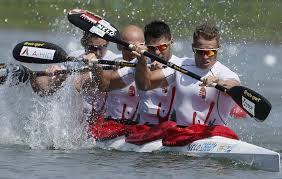
Canoe Slalom is contested by two types of boat, canoe (C) and kayak (K). In canoe, a single-blade paddle is used by an athlete who is strapped into the boat with their legs bent at the knees and tucked under their body, in contrast to the double-bladed paddle used in a seated position in kayak. At international level there are six individual events: women’s kayak (WW1), men’s kayak (), women’s canoe (WW1), men’s canoe (), women’s kayak cross (WW1) and men’s kayak cross (MX1).
Canoe and kayak events are timed events where competitors navigate a whitewater course by passing through a combination of upstream and downstream gates. Each course is different but can be a maximum of 300 metres in length and contain a maximum of 25 gates, with a minimum of six upstream gates. The type of gate is designated by colour – red for upstream and green for downstream. Courses are designed so the leading athletes will complete them in a time of between 90 and 110 seconds, though time penalties can be incurred for touching a gate (two seconds) and missing a gate (50 seconds).
Canoe Slalom originated in Switzerland in 1933 as a summer alternative to slalom skiing, and was initially competed on a flatwater course. Switzerland hosted the first World Championships in Geneva in 1949 and the discipline made its Olympic debut as an introduction sport at the 1972 Games in Munich, when all four gold medals were won by East Germany. It was a further 20 years before Canoe Slalom returned to the Olympic Games, but this time as a core sport.
The WC1 event made its debut at the 2020 Olympic Games in Tokyo, replacing the men’s C2, which had been part of the Olympic programme in 1972 and then from 1992 until 2016. The decision to replace the men’s C2 with the women’s C1 for the 2020 Olympics was taken to ensure Canoe Slalom met the IOC’s gender equity criteria.
Slovakia hold the record for most gold medals in Canoe Slalom at the Olympic Games with eight. The only three people to claim more than three medals in the discipline at the Games are all Slovakian – Michal Martikán (two gold, two silver, one bronze) and twins Pavol and Peter Hochschorner (three gold and one bronze). The Hochschorners finished on the podium in the MC2 at four consecutive Olympic Games – 2004, 2008, 2012 and 2016.
France haswon the most world titles in Canoe Slalom with 61 but combining Czechoslovakia (33), Czech Republic (30) and Slovakia (25) would exceed that total. Martikan (15) has won the most world titles in the discipline (individual and team events), while the leading female is Jessica Fox (10) of Australia. A paddler representing Africa has never finished in the top-three at the World Championships, but in 2008 in Beijing, Benjamin Boukpeti claimed Togo’s first medal in any sport at the Olympic Games when he took bronze in the MK1.
What is Kayak Cross?
Kayak Cross is a combination of all canoeing’s whitewater disciplines, with competitors racing in identical plastic creek boats. The excitement begins from the very start, with four competitors sliding off a ramp more than two metres above the water and splashing onto the course as one. From there it’s a race to the first buoy, and it really is a case of anything goes as each paddler tries to steal an advantage over their opponents. Athletes need to negotiate both downstream and upstream buoys, and contact is allowed – adding to the thrills and spills and excitement for spectators and athletes alike. Then there’s the compulsory kayak roll. Athletes only have a short window of opportunity to successfully roll their kayaks, and they need to do a complete 360 degree flip. There are a variety of ways to get penalized – breaking the start, missing a buoy, dangerous paddling, and failing to complete the kayak roll within the allocated area. Most races are over in around a minute, but times are not important. Kayak Cross is very much a race of tactics, and often it does not pay to lead early.
One of the major attractions of Kayak Cross is the diversity of countries taking part. Athletes from regions where Canoe Slalom is still in its infancy are embracing cross events, and the results have been very exciting.
Leave a Reply